Hierarchy and Power in Healthcare system Australia
VerifiedAdded on 2023/06/03
|12
|3464
|301
AI Summary
This paper discusses the history of the health care for systems in Australia, hierarchy, and power, and the current nature and the strategies set aside by the Australian government to improve healthcare. It also evaluates the implications of the theory to the healthcare systems.
Contribute Materials
Your contribution can guide someone’s learning journey. Share your
documents today.
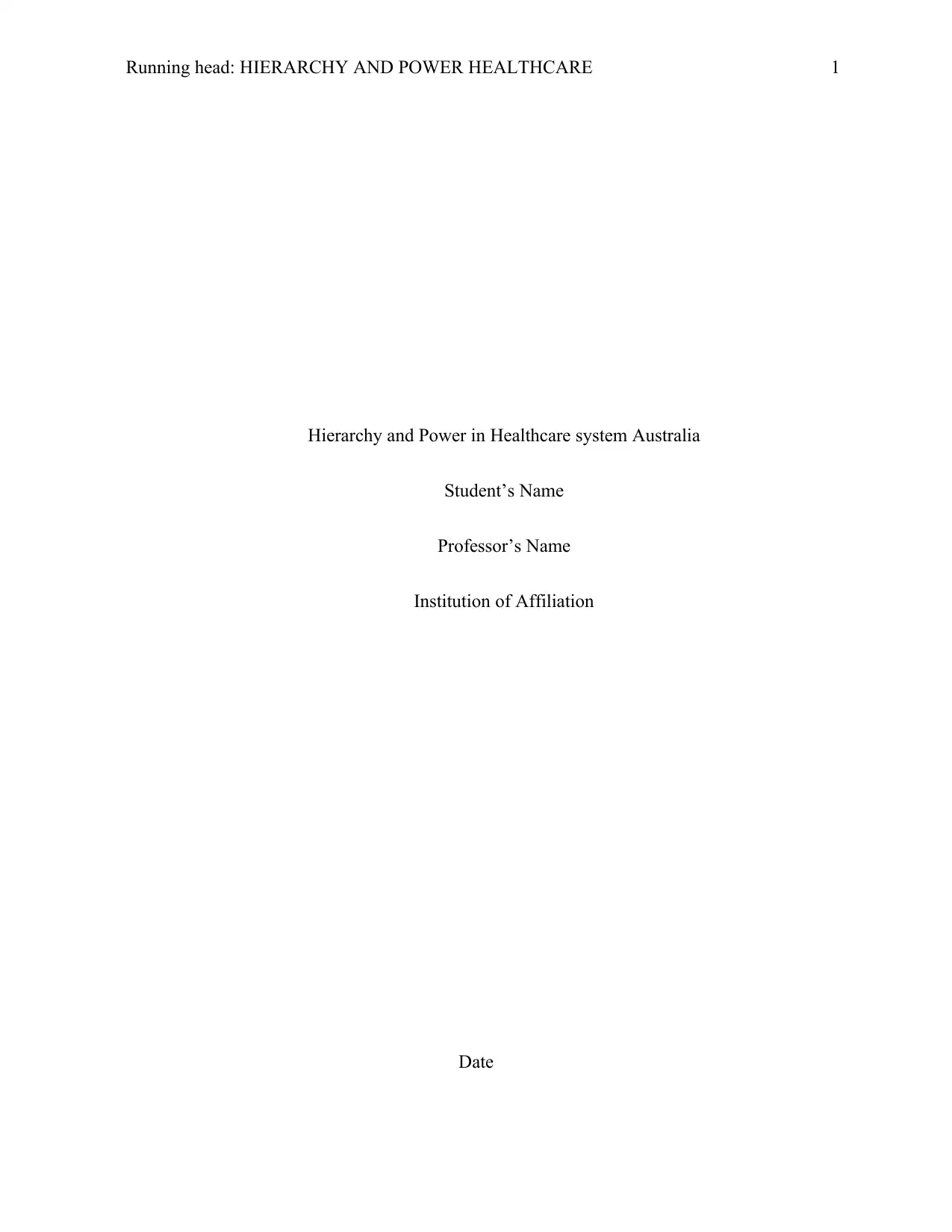
Running head: HIERARCHY AND POWER HEALTHCARE 1
Hierarchy and Power in Healthcare system Australia
Student’s Name
Professor’s Name
Institution of Affiliation
Date
Hierarchy and Power in Healthcare system Australia
Student’s Name
Professor’s Name
Institution of Affiliation
Date
Secure Best Marks with AI Grader
Need help grading? Try our AI Grader for instant feedback on your assignments.
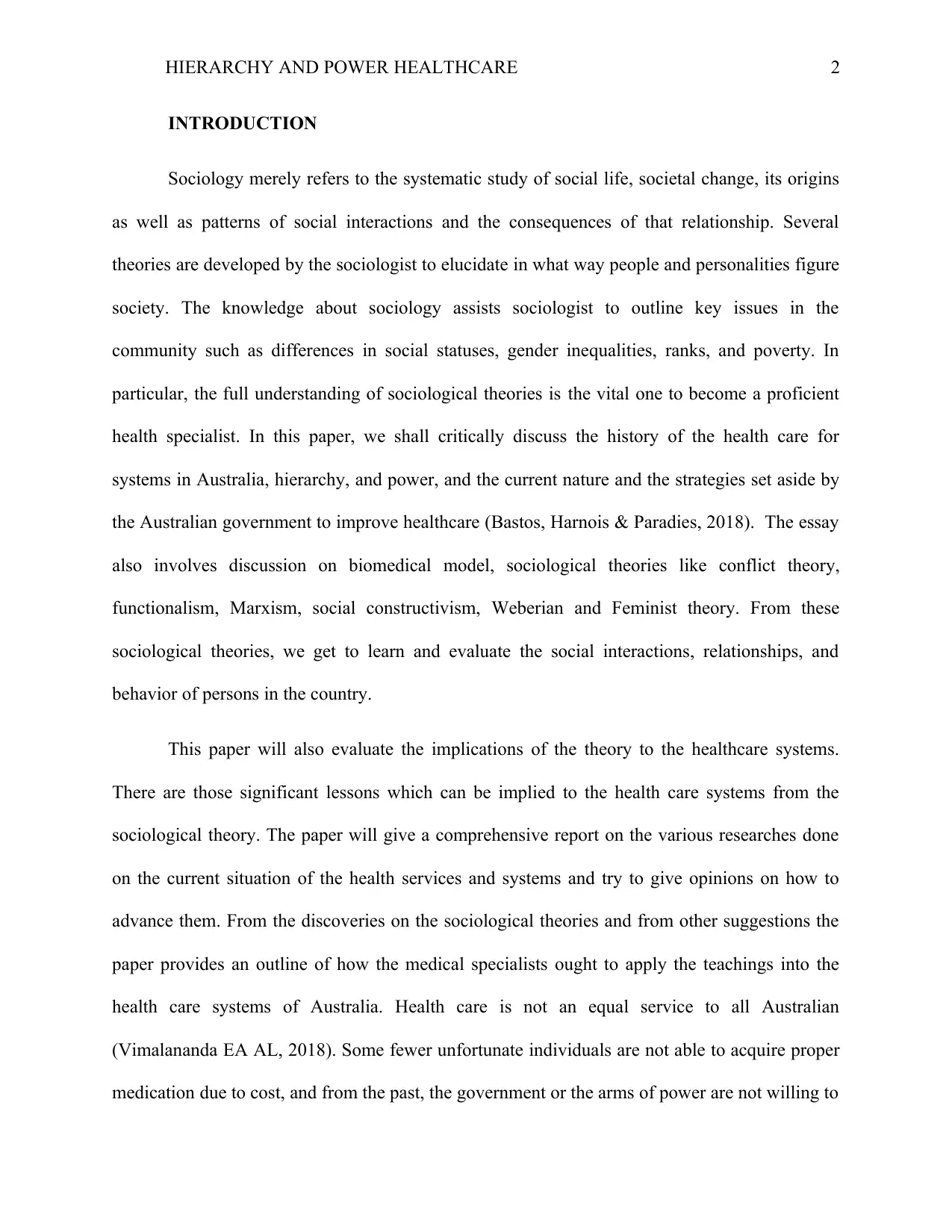
HIERARCHY AND POWER HEALTHCARE 2
INTRODUCTION
Sociology merely refers to the systematic study of social life, societal change, its origins
as well as patterns of social interactions and the consequences of that relationship. Several
theories are developed by the sociologist to elucidate in what way people and personalities figure
society. The knowledge about sociology assists sociologist to outline key issues in the
community such as differences in social statuses, gender inequalities, ranks, and poverty. In
particular, the full understanding of sociological theories is the vital one to become a proficient
health specialist. In this paper, we shall critically discuss the history of the health care for
systems in Australia, hierarchy, and power, and the current nature and the strategies set aside by
the Australian government to improve healthcare (Bastos, Harnois & Paradies, 2018). The essay
also involves discussion on biomedical model, sociological theories like conflict theory,
functionalism, Marxism, social constructivism, Weberian and Feminist theory. From these
sociological theories, we get to learn and evaluate the social interactions, relationships, and
behavior of persons in the country.
This paper will also evaluate the implications of the theory to the healthcare systems.
There are those significant lessons which can be implied to the health care systems from the
sociological theory. The paper will give a comprehensive report on the various researches done
on the current situation of the health services and systems and try to give opinions on how to
advance them. From the discoveries on the sociological theories and from other suggestions the
paper provides an outline of how the medical specialists ought to apply the teachings into the
health care systems of Australia. Health care is not an equal service to all Australian
(Vimalananda EA AL, 2018). Some fewer unfortunate individuals are not able to acquire proper
medication due to cost, and from the past, the government or the arms of power are not willing to
INTRODUCTION
Sociology merely refers to the systematic study of social life, societal change, its origins
as well as patterns of social interactions and the consequences of that relationship. Several
theories are developed by the sociologist to elucidate in what way people and personalities figure
society. The knowledge about sociology assists sociologist to outline key issues in the
community such as differences in social statuses, gender inequalities, ranks, and poverty. In
particular, the full understanding of sociological theories is the vital one to become a proficient
health specialist. In this paper, we shall critically discuss the history of the health care for
systems in Australia, hierarchy, and power, and the current nature and the strategies set aside by
the Australian government to improve healthcare (Bastos, Harnois & Paradies, 2018). The essay
also involves discussion on biomedical model, sociological theories like conflict theory,
functionalism, Marxism, social constructivism, Weberian and Feminist theory. From these
sociological theories, we get to learn and evaluate the social interactions, relationships, and
behavior of persons in the country.
This paper will also evaluate the implications of the theory to the healthcare systems.
There are those significant lessons which can be implied to the health care systems from the
sociological theory. The paper will give a comprehensive report on the various researches done
on the current situation of the health services and systems and try to give opinions on how to
advance them. From the discoveries on the sociological theories and from other suggestions the
paper provides an outline of how the medical specialists ought to apply the teachings into the
health care systems of Australia. Health care is not an equal service to all Australian
(Vimalananda EA AL, 2018). Some fewer unfortunate individuals are not able to acquire proper
medication due to cost, and from the past, the government or the arms of power are not willing to

HIERARCHY AND POWER HEALTHCARE 3
offer any form of assistance. The question is, are these people not part of the country? How does
the government expect them to survive without proper health care services?
Finally, an outline of how hierarchy and power being intrinsic to the current health care
system in Australia can impact the health practitioners.
An account of Australia Healthcare Scheme
Australia has the most outstanding healthcare scheme and is among the paramount
scheme in the entire continent. The scheme that caters for the Australian's citizens and those who
stay there is known as medical care short formed has Medicare. Medicare was established in the
year 1984, and its primary objective was to ensure that residents of Australia could get
medication in the public clinics freely (Reeve et al, 2018). Up to date, Medicare is operating, and
a multiple of advancement has taken place has it will be discussed in this essay. The most
significant issues to know is that Medicare health system receives financial from the government
of Australia and the government also controls its operation and policies (Watts et al, 2018).
Structure of Australia health care system
Australia nation has got different categories of government that have the mandate to
providing finances to facilitate the operation of the health system which involves state
government, the federal government, local government, and territory government. Another
source of money is from the non-government organizations as well as medical charges made
from the people who pay for medication using their own money. There are multiple of
organizations that are responsible for offering health services which include: nurses, health
offer any form of assistance. The question is, are these people not part of the country? How does
the government expect them to survive without proper health care services?
Finally, an outline of how hierarchy and power being intrinsic to the current health care
system in Australia can impact the health practitioners.
An account of Australia Healthcare Scheme
Australia has the most outstanding healthcare scheme and is among the paramount
scheme in the entire continent. The scheme that caters for the Australian's citizens and those who
stay there is known as medical care short formed has Medicare. Medicare was established in the
year 1984, and its primary objective was to ensure that residents of Australia could get
medication in the public clinics freely (Reeve et al, 2018). Up to date, Medicare is operating, and
a multiple of advancement has taken place has it will be discussed in this essay. The most
significant issues to know is that Medicare health system receives financial from the government
of Australia and the government also controls its operation and policies (Watts et al, 2018).
Structure of Australia health care system
Australia nation has got different categories of government that have the mandate to
providing finances to facilitate the operation of the health system which involves state
government, the federal government, local government, and territory government. Another
source of money is from the non-government organizations as well as medical charges made
from the people who pay for medication using their own money. There are multiple of
organizations that are responsible for offering health services which include: nurses, health
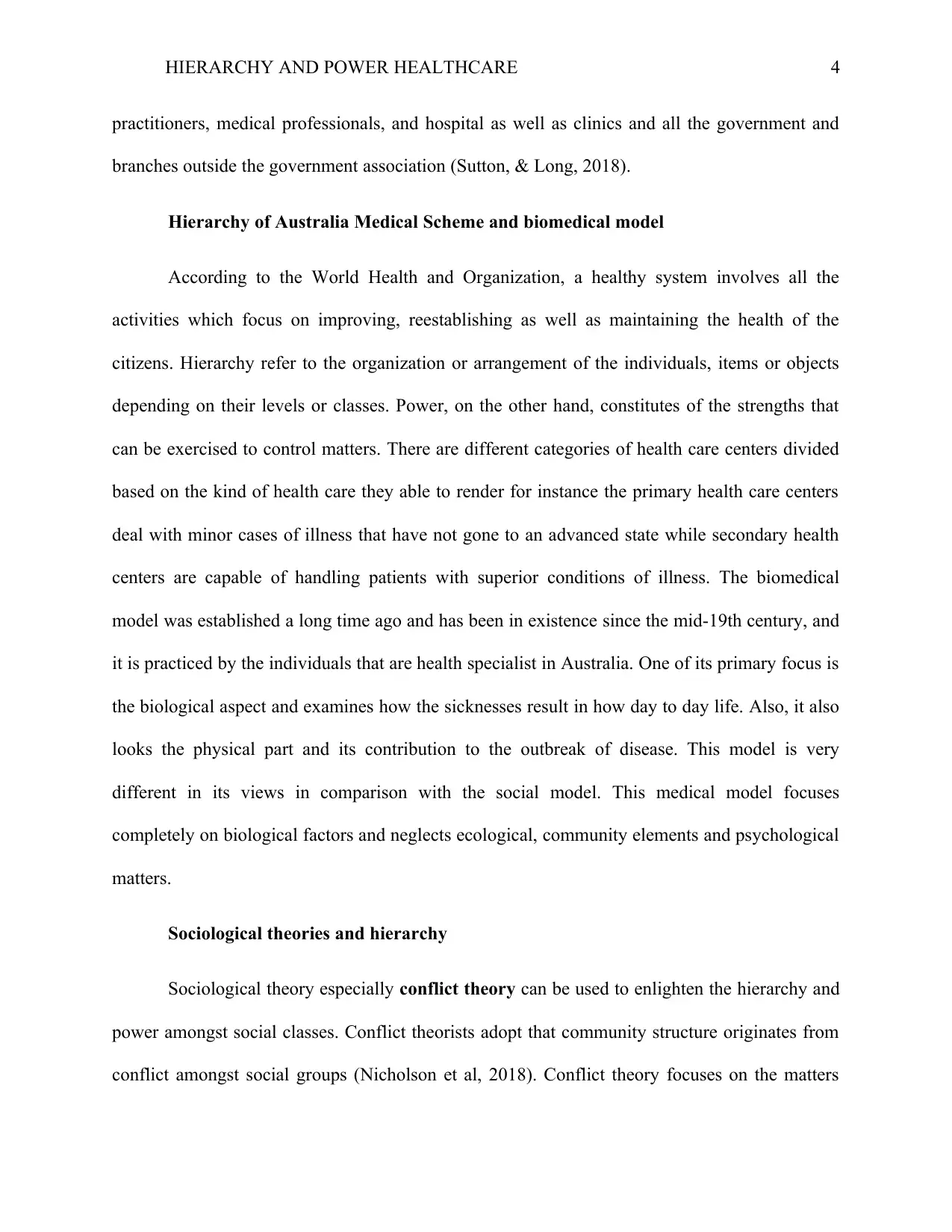
HIERARCHY AND POWER HEALTHCARE 4
practitioners, medical professionals, and hospital as well as clinics and all the government and
branches outside the government association (Sutton, & Long, 2018).
Hierarchy of Australia Medical Scheme and biomedical model
According to the World Health and Organization, a healthy system involves all the
activities which focus on improving, reestablishing as well as maintaining the health of the
citizens. Hierarchy refer to the organization or arrangement of the individuals, items or objects
depending on their levels or classes. Power, on the other hand, constitutes of the strengths that
can be exercised to control matters. There are different categories of health care centers divided
based on the kind of health care they able to render for instance the primary health care centers
deal with minor cases of illness that have not gone to an advanced state while secondary health
centers are capable of handling patients with superior conditions of illness. The biomedical
model was established a long time ago and has been in existence since the mid-19th century, and
it is practiced by the individuals that are health specialist in Australia. One of its primary focus is
the biological aspect and examines how the sicknesses result in how day to day life. Also, it also
looks the physical part and its contribution to the outbreak of disease. This model is very
different in its views in comparison with the social model. This medical model focuses
completely on biological factors and neglects ecological, community elements and psychological
matters.
Sociological theories and hierarchy
Sociological theory especially conflict theory can be used to enlighten the hierarchy and
power amongst social classes. Conflict theorists adopt that community structure originates from
conflict amongst social groups (Nicholson et al, 2018). Conflict theory focuses on the matters
practitioners, medical professionals, and hospital as well as clinics and all the government and
branches outside the government association (Sutton, & Long, 2018).
Hierarchy of Australia Medical Scheme and biomedical model
According to the World Health and Organization, a healthy system involves all the
activities which focus on improving, reestablishing as well as maintaining the health of the
citizens. Hierarchy refer to the organization or arrangement of the individuals, items or objects
depending on their levels or classes. Power, on the other hand, constitutes of the strengths that
can be exercised to control matters. There are different categories of health care centers divided
based on the kind of health care they able to render for instance the primary health care centers
deal with minor cases of illness that have not gone to an advanced state while secondary health
centers are capable of handling patients with superior conditions of illness. The biomedical
model was established a long time ago and has been in existence since the mid-19th century, and
it is practiced by the individuals that are health specialist in Australia. One of its primary focus is
the biological aspect and examines how the sicknesses result in how day to day life. Also, it also
looks the physical part and its contribution to the outbreak of disease. This model is very
different in its views in comparison with the social model. This medical model focuses
completely on biological factors and neglects ecological, community elements and psychological
matters.
Sociological theories and hierarchy
Sociological theory especially conflict theory can be used to enlighten the hierarchy and
power amongst social classes. Conflict theorists adopt that community structure originates from
conflict amongst social groups (Nicholson et al, 2018). Conflict theory focuses on the matters
Secure Best Marks with AI Grader
Need help grading? Try our AI Grader for instant feedback on your assignments.
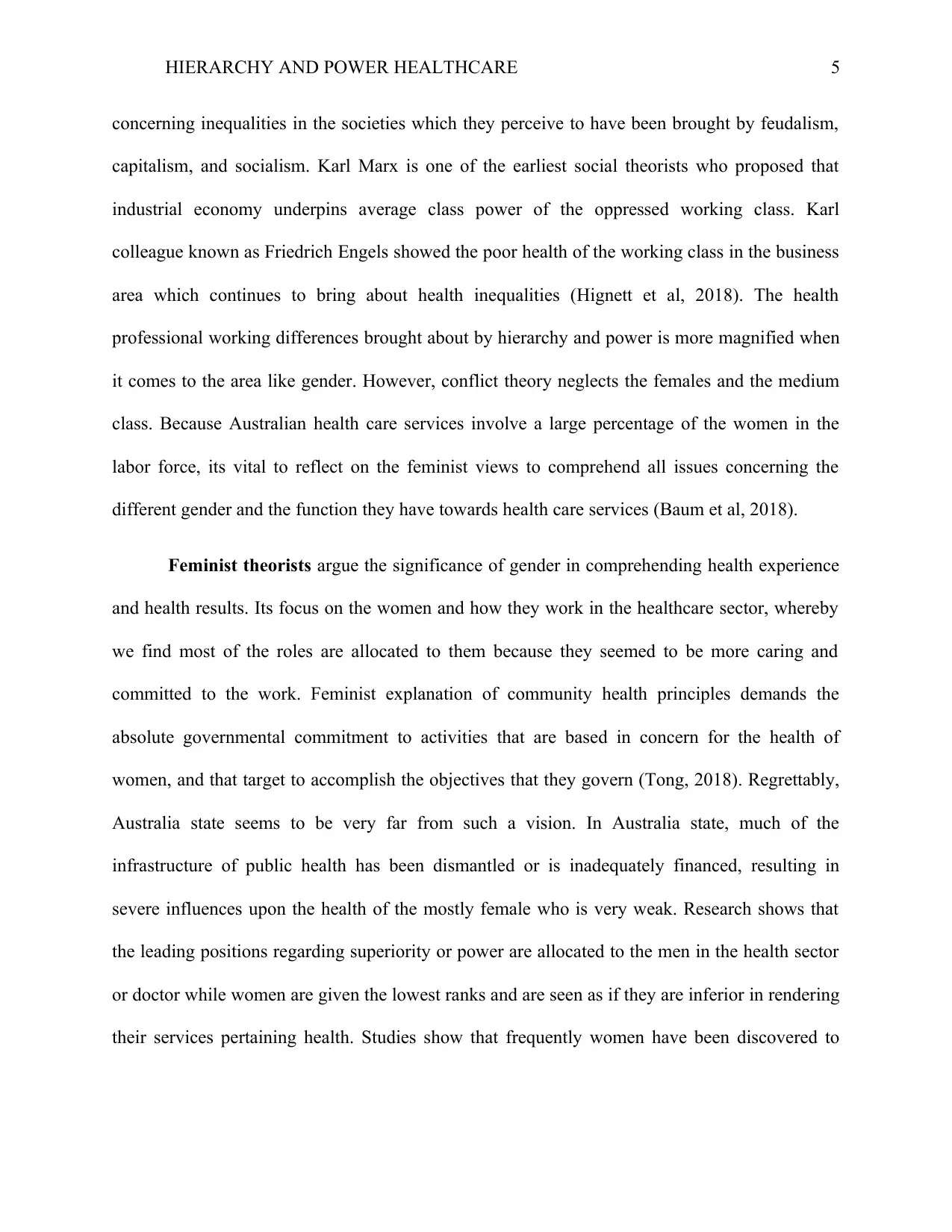
HIERARCHY AND POWER HEALTHCARE 5
concerning inequalities in the societies which they perceive to have been brought by feudalism,
capitalism, and socialism. Karl Marx is one of the earliest social theorists who proposed that
industrial economy underpins average class power of the oppressed working class. Karl
colleague known as Friedrich Engels showed the poor health of the working class in the business
area which continues to bring about health inequalities (Hignett et al, 2018). The health
professional working differences brought about by hierarchy and power is more magnified when
it comes to the area like gender. However, conflict theory neglects the females and the medium
class. Because Australian health care services involve a large percentage of the women in the
labor force, its vital to reflect on the feminist views to comprehend all issues concerning the
different gender and the function they have towards health care services (Baum et al, 2018).
Feminist theorists argue the significance of gender in comprehending health experience
and health results. Its focus on the women and how they work in the healthcare sector, whereby
we find most of the roles are allocated to them because they seemed to be more caring and
committed to the work. Feminist explanation of community health principles demands the
absolute governmental commitment to activities that are based in concern for the health of
women, and that target to accomplish the objectives that they govern (Tong, 2018). Regrettably,
Australia state seems to be very far from such a vision. In Australia state, much of the
infrastructure of public health has been dismantled or is inadequately financed, resulting in
severe influences upon the health of the mostly female who is very weak. Research shows that
the leading positions regarding superiority or power are allocated to the men in the health sector
or doctor while women are given the lowest ranks and are seen as if they are inferior in rendering
their services pertaining health. Studies show that frequently women have been discovered to
concerning inequalities in the societies which they perceive to have been brought by feudalism,
capitalism, and socialism. Karl Marx is one of the earliest social theorists who proposed that
industrial economy underpins average class power of the oppressed working class. Karl
colleague known as Friedrich Engels showed the poor health of the working class in the business
area which continues to bring about health inequalities (Hignett et al, 2018). The health
professional working differences brought about by hierarchy and power is more magnified when
it comes to the area like gender. However, conflict theory neglects the females and the medium
class. Because Australian health care services involve a large percentage of the women in the
labor force, its vital to reflect on the feminist views to comprehend all issues concerning the
different gender and the function they have towards health care services (Baum et al, 2018).
Feminist theorists argue the significance of gender in comprehending health experience
and health results. Its focus on the women and how they work in the healthcare sector, whereby
we find most of the roles are allocated to them because they seemed to be more caring and
committed to the work. Feminist explanation of community health principles demands the
absolute governmental commitment to activities that are based in concern for the health of
women, and that target to accomplish the objectives that they govern (Tong, 2018). Regrettably,
Australia state seems to be very far from such a vision. In Australia state, much of the
infrastructure of public health has been dismantled or is inadequately financed, resulting in
severe influences upon the health of the mostly female who is very weak. Research shows that
the leading positions regarding superiority or power are allocated to the men in the health sector
or doctor while women are given the lowest ranks and are seen as if they are inferior in rendering
their services pertaining health. Studies show that frequently women have been discovered to
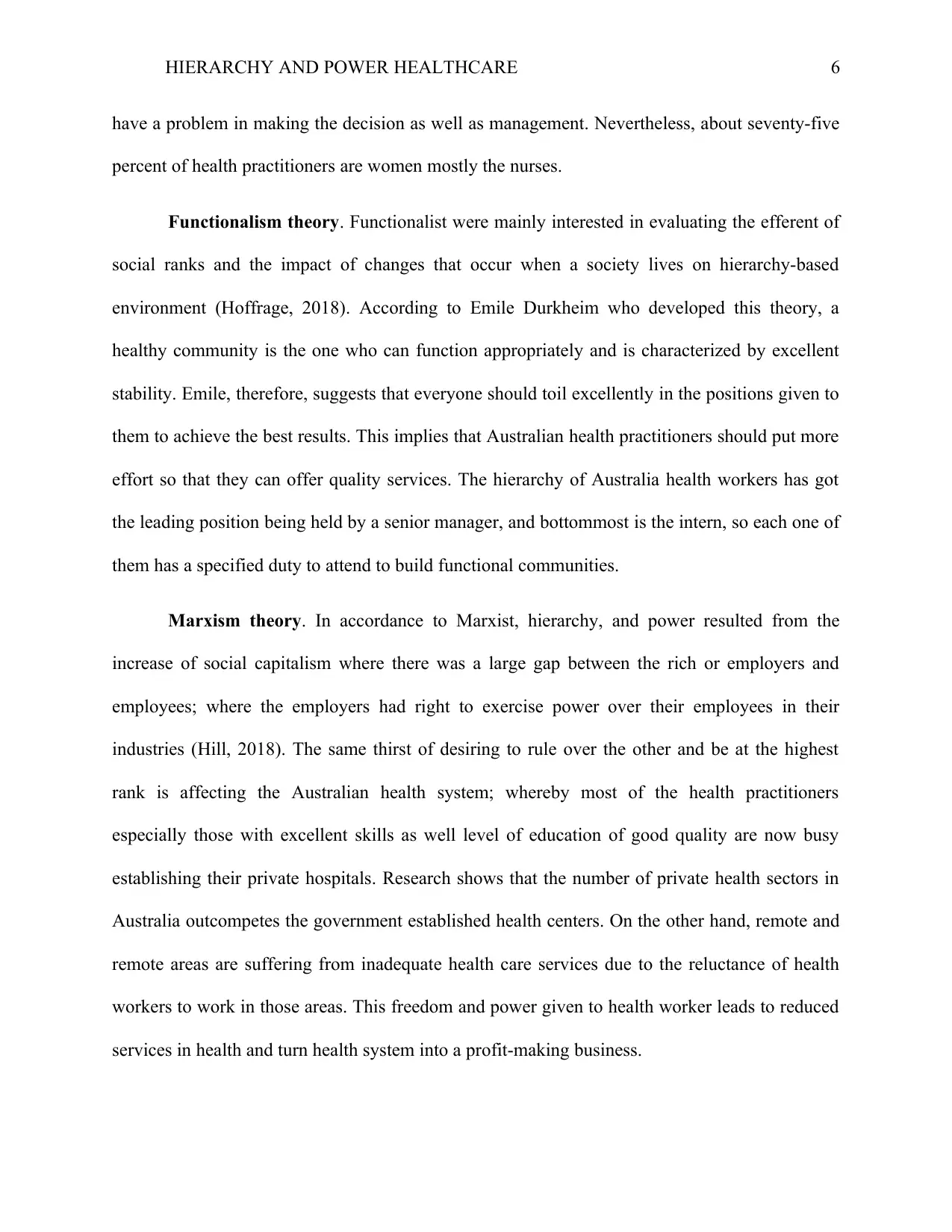
HIERARCHY AND POWER HEALTHCARE 6
have a problem in making the decision as well as management. Nevertheless, about seventy-five
percent of health practitioners are women mostly the nurses.
Functionalism theory. Functionalist were mainly interested in evaluating the efferent of
social ranks and the impact of changes that occur when a society lives on hierarchy-based
environment (Hoffrage, 2018). According to Emile Durkheim who developed this theory, a
healthy community is the one who can function appropriately and is characterized by excellent
stability. Emile, therefore, suggests that everyone should toil excellently in the positions given to
them to achieve the best results. This implies that Australian health practitioners should put more
effort so that they can offer quality services. The hierarchy of Australia health workers has got
the leading position being held by a senior manager, and bottommost is the intern, so each one of
them has a specified duty to attend to build functional communities.
Marxism theory. In accordance to Marxist, hierarchy, and power resulted from the
increase of social capitalism where there was a large gap between the rich or employers and
employees; where the employers had right to exercise power over their employees in their
industries (Hill, 2018). The same thirst of desiring to rule over the other and be at the highest
rank is affecting the Australian health system; whereby most of the health practitioners
especially those with excellent skills as well level of education of good quality are now busy
establishing their private hospitals. Research shows that the number of private health sectors in
Australia outcompetes the government established health centers. On the other hand, remote and
remote areas are suffering from inadequate health care services due to the reluctance of health
workers to work in those areas. This freedom and power given to health worker leads to reduced
services in health and turn health system into a profit-making business.
have a problem in making the decision as well as management. Nevertheless, about seventy-five
percent of health practitioners are women mostly the nurses.
Functionalism theory. Functionalist were mainly interested in evaluating the efferent of
social ranks and the impact of changes that occur when a society lives on hierarchy-based
environment (Hoffrage, 2018). According to Emile Durkheim who developed this theory, a
healthy community is the one who can function appropriately and is characterized by excellent
stability. Emile, therefore, suggests that everyone should toil excellently in the positions given to
them to achieve the best results. This implies that Australian health practitioners should put more
effort so that they can offer quality services. The hierarchy of Australia health workers has got
the leading position being held by a senior manager, and bottommost is the intern, so each one of
them has a specified duty to attend to build functional communities.
Marxism theory. In accordance to Marxist, hierarchy, and power resulted from the
increase of social capitalism where there was a large gap between the rich or employers and
employees; where the employers had right to exercise power over their employees in their
industries (Hill, 2018). The same thirst of desiring to rule over the other and be at the highest
rank is affecting the Australian health system; whereby most of the health practitioners
especially those with excellent skills as well level of education of good quality are now busy
establishing their private hospitals. Research shows that the number of private health sectors in
Australia outcompetes the government established health centers. On the other hand, remote and
remote areas are suffering from inadequate health care services due to the reluctance of health
workers to work in those areas. This freedom and power given to health worker leads to reduced
services in health and turn health system into a profit-making business.
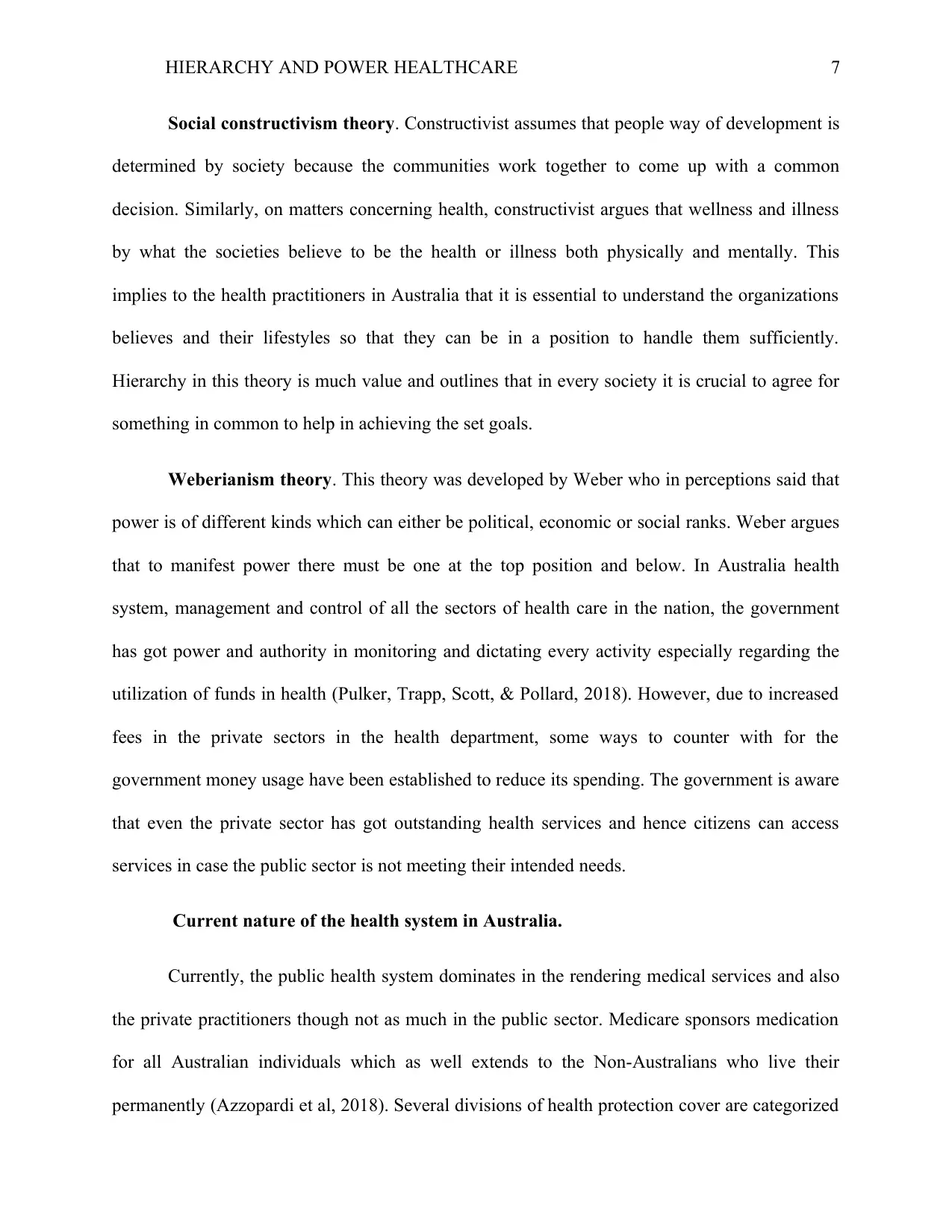
HIERARCHY AND POWER HEALTHCARE 7
Social constructivism theory. Constructivist assumes that people way of development is
determined by society because the communities work together to come up with a common
decision. Similarly, on matters concerning health, constructivist argues that wellness and illness
by what the societies believe to be the health or illness both physically and mentally. This
implies to the health practitioners in Australia that it is essential to understand the organizations
believes and their lifestyles so that they can be in a position to handle them sufficiently.
Hierarchy in this theory is much value and outlines that in every society it is crucial to agree for
something in common to help in achieving the set goals.
Weberianism theory. This theory was developed by Weber who in perceptions said that
power is of different kinds which can either be political, economic or social ranks. Weber argues
that to manifest power there must be one at the top position and below. In Australia health
system, management and control of all the sectors of health care in the nation, the government
has got power and authority in monitoring and dictating every activity especially regarding the
utilization of funds in health (Pulker, Trapp, Scott, & Pollard, 2018). However, due to increased
fees in the private sectors in the health department, some ways to counter with for the
government money usage have been established to reduce its spending. The government is aware
that even the private sector has got outstanding health services and hence citizens can access
services in case the public sector is not meeting their intended needs.
Current nature of the health system in Australia.
Currently, the public health system dominates in the rendering medical services and also
the private practitioners though not as much in the public sector. Medicare sponsors medication
for all Australian individuals which as well extends to the Non-Australians who live their
permanently (Azzopardi et al, 2018). Several divisions of health protection cover are categorized
Social constructivism theory. Constructivist assumes that people way of development is
determined by society because the communities work together to come up with a common
decision. Similarly, on matters concerning health, constructivist argues that wellness and illness
by what the societies believe to be the health or illness both physically and mentally. This
implies to the health practitioners in Australia that it is essential to understand the organizations
believes and their lifestyles so that they can be in a position to handle them sufficiently.
Hierarchy in this theory is much value and outlines that in every society it is crucial to agree for
something in common to help in achieving the set goals.
Weberianism theory. This theory was developed by Weber who in perceptions said that
power is of different kinds which can either be political, economic or social ranks. Weber argues
that to manifest power there must be one at the top position and below. In Australia health
system, management and control of all the sectors of health care in the nation, the government
has got power and authority in monitoring and dictating every activity especially regarding the
utilization of funds in health (Pulker, Trapp, Scott, & Pollard, 2018). However, due to increased
fees in the private sectors in the health department, some ways to counter with for the
government money usage have been established to reduce its spending. The government is aware
that even the private sector has got outstanding health services and hence citizens can access
services in case the public sector is not meeting their intended needs.
Current nature of the health system in Australia.
Currently, the public health system dominates in the rendering medical services and also
the private practitioners though not as much in the public sector. Medicare sponsors medication
for all Australian individuals which as well extends to the Non-Australians who live their
permanently (Azzopardi et al, 2018). Several divisions of health protection cover are categorized
Paraphrase This Document
Need a fresh take? Get an instant paraphrase of this document with our AI Paraphraser
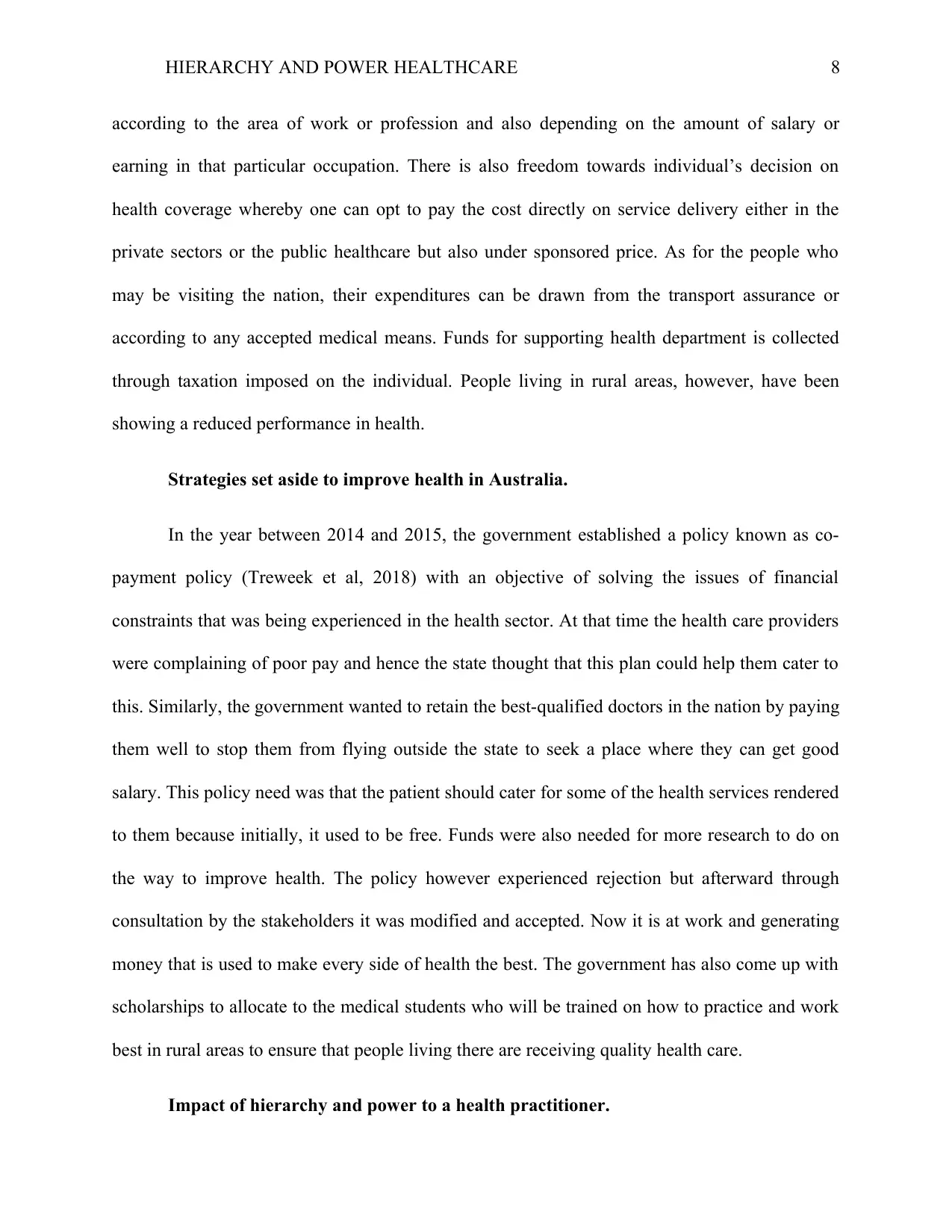
HIERARCHY AND POWER HEALTHCARE 8
according to the area of work or profession and also depending on the amount of salary or
earning in that particular occupation. There is also freedom towards individual’s decision on
health coverage whereby one can opt to pay the cost directly on service delivery either in the
private sectors or the public healthcare but also under sponsored price. As for the people who
may be visiting the nation, their expenditures can be drawn from the transport assurance or
according to any accepted medical means. Funds for supporting health department is collected
through taxation imposed on the individual. People living in rural areas, however, have been
showing a reduced performance in health.
Strategies set aside to improve health in Australia.
In the year between 2014 and 2015, the government established a policy known as co-
payment policy (Treweek et al, 2018) with an objective of solving the issues of financial
constraints that was being experienced in the health sector. At that time the health care providers
were complaining of poor pay and hence the state thought that this plan could help them cater to
this. Similarly, the government wanted to retain the best-qualified doctors in the nation by paying
them well to stop them from flying outside the state to seek a place where they can get good
salary. This policy need was that the patient should cater for some of the health services rendered
to them because initially, it used to be free. Funds were also needed for more research to do on
the way to improve health. The policy however experienced rejection but afterward through
consultation by the stakeholders it was modified and accepted. Now it is at work and generating
money that is used to make every side of health the best. The government has also come up with
scholarships to allocate to the medical students who will be trained on how to practice and work
best in rural areas to ensure that people living there are receiving quality health care.
Impact of hierarchy and power to a health practitioner.
according to the area of work or profession and also depending on the amount of salary or
earning in that particular occupation. There is also freedom towards individual’s decision on
health coverage whereby one can opt to pay the cost directly on service delivery either in the
private sectors or the public healthcare but also under sponsored price. As for the people who
may be visiting the nation, their expenditures can be drawn from the transport assurance or
according to any accepted medical means. Funds for supporting health department is collected
through taxation imposed on the individual. People living in rural areas, however, have been
showing a reduced performance in health.
Strategies set aside to improve health in Australia.
In the year between 2014 and 2015, the government established a policy known as co-
payment policy (Treweek et al, 2018) with an objective of solving the issues of financial
constraints that was being experienced in the health sector. At that time the health care providers
were complaining of poor pay and hence the state thought that this plan could help them cater to
this. Similarly, the government wanted to retain the best-qualified doctors in the nation by paying
them well to stop them from flying outside the state to seek a place where they can get good
salary. This policy need was that the patient should cater for some of the health services rendered
to them because initially, it used to be free. Funds were also needed for more research to do on
the way to improve health. The policy however experienced rejection but afterward through
consultation by the stakeholders it was modified and accepted. Now it is at work and generating
money that is used to make every side of health the best. The government has also come up with
scholarships to allocate to the medical students who will be trained on how to practice and work
best in rural areas to ensure that people living there are receiving quality health care.
Impact of hierarchy and power to a health practitioner.
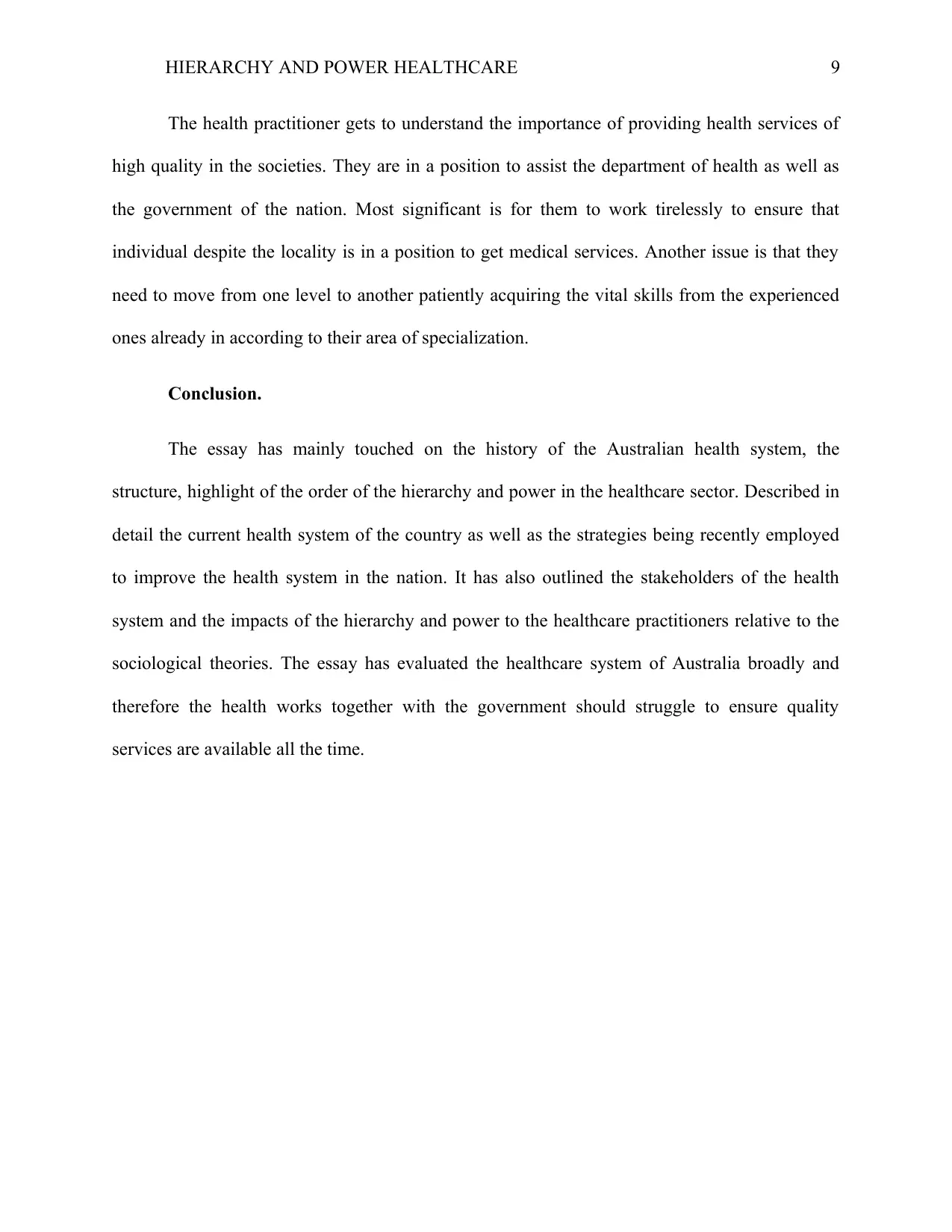
HIERARCHY AND POWER HEALTHCARE 9
The health practitioner gets to understand the importance of providing health services of
high quality in the societies. They are in a position to assist the department of health as well as
the government of the nation. Most significant is for them to work tirelessly to ensure that
individual despite the locality is in a position to get medical services. Another issue is that they
need to move from one level to another patiently acquiring the vital skills from the experienced
ones already in according to their area of specialization.
Conclusion.
The essay has mainly touched on the history of the Australian health system, the
structure, highlight of the order of the hierarchy and power in the healthcare sector. Described in
detail the current health system of the country as well as the strategies being recently employed
to improve the health system in the nation. It has also outlined the stakeholders of the health
system and the impacts of the hierarchy and power to the healthcare practitioners relative to the
sociological theories. The essay has evaluated the healthcare system of Australia broadly and
therefore the health works together with the government should struggle to ensure quality
services are available all the time.
The health practitioner gets to understand the importance of providing health services of
high quality in the societies. They are in a position to assist the department of health as well as
the government of the nation. Most significant is for them to work tirelessly to ensure that
individual despite the locality is in a position to get medical services. Another issue is that they
need to move from one level to another patiently acquiring the vital skills from the experienced
ones already in according to their area of specialization.
Conclusion.
The essay has mainly touched on the history of the Australian health system, the
structure, highlight of the order of the hierarchy and power in the healthcare sector. Described in
detail the current health system of the country as well as the strategies being recently employed
to improve the health system in the nation. It has also outlined the stakeholders of the health
system and the impacts of the hierarchy and power to the healthcare practitioners relative to the
sociological theories. The essay has evaluated the healthcare system of Australia broadly and
therefore the health works together with the government should struggle to ensure quality
services are available all the time.
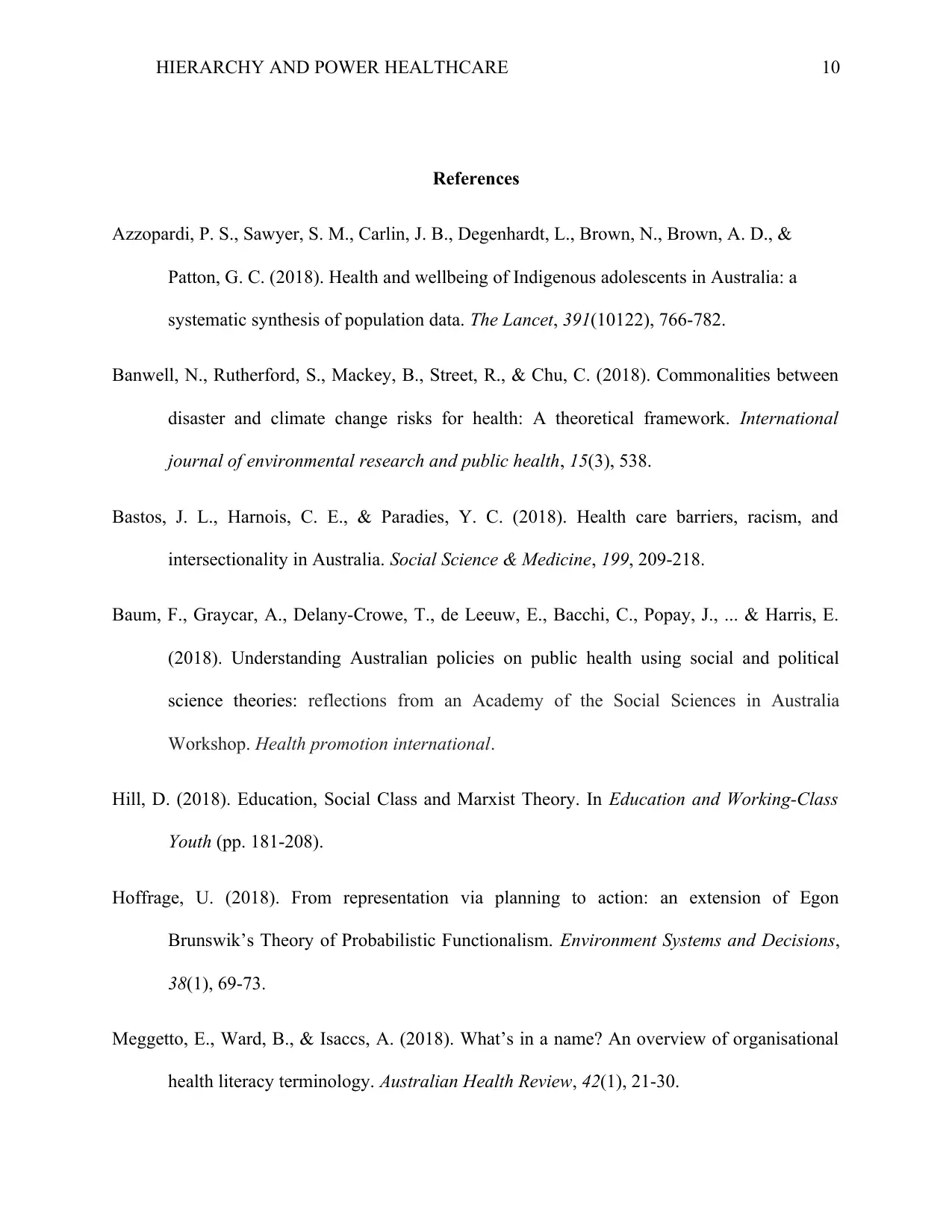
HIERARCHY AND POWER HEALTHCARE 10
References
Azzopardi, P. S., Sawyer, S. M., Carlin, J. B., Degenhardt, L., Brown, N., Brown, A. D., &
Patton, G. C. (2018). Health and wellbeing of Indigenous adolescents in Australia: a
systematic synthesis of population data. The Lancet, 391(10122), 766-782.
Banwell, N., Rutherford, S., Mackey, B., Street, R., & Chu, C. (2018). Commonalities between
disaster and climate change risks for health: A theoretical framework. International
journal of environmental research and public health, 15(3), 538.
Bastos, J. L., Harnois, C. E., & Paradies, Y. C. (2018). Health care barriers, racism, and
intersectionality in Australia. Social Science & Medicine, 199, 209-218.
Baum, F., Graycar, A., Delany-Crowe, T., de Leeuw, E., Bacchi, C., Popay, J., ... & Harris, E.
(2018). Understanding Australian policies on public health using social and political
science theories: reflections from an Academy of the Social Sciences in Australia
Workshop. Health promotion international.
Hill, D. (2018). Education, Social Class and Marxist Theory. In Education and Working-Class
Youth (pp. 181-208).
Hoffrage, U. (2018). From representation via planning to action: an extension of Egon
Brunswik’s Theory of Probabilistic Functionalism. Environment Systems and Decisions,
38(1), 69-73.
Meggetto, E., Ward, B., & Isaccs, A. (2018). What’s in a name? An overview of organisational
health literacy terminology. Australian Health Review, 42(1), 21-30.
References
Azzopardi, P. S., Sawyer, S. M., Carlin, J. B., Degenhardt, L., Brown, N., Brown, A. D., &
Patton, G. C. (2018). Health and wellbeing of Indigenous adolescents in Australia: a
systematic synthesis of population data. The Lancet, 391(10122), 766-782.
Banwell, N., Rutherford, S., Mackey, B., Street, R., & Chu, C. (2018). Commonalities between
disaster and climate change risks for health: A theoretical framework. International
journal of environmental research and public health, 15(3), 538.
Bastos, J. L., Harnois, C. E., & Paradies, Y. C. (2018). Health care barriers, racism, and
intersectionality in Australia. Social Science & Medicine, 199, 209-218.
Baum, F., Graycar, A., Delany-Crowe, T., de Leeuw, E., Bacchi, C., Popay, J., ... & Harris, E.
(2018). Understanding Australian policies on public health using social and political
science theories: reflections from an Academy of the Social Sciences in Australia
Workshop. Health promotion international.
Hill, D. (2018). Education, Social Class and Marxist Theory. In Education and Working-Class
Youth (pp. 181-208).
Hoffrage, U. (2018). From representation via planning to action: an extension of Egon
Brunswik’s Theory of Probabilistic Functionalism. Environment Systems and Decisions,
38(1), 69-73.
Meggetto, E., Ward, B., & Isaccs, A. (2018). What’s in a name? An overview of organisational
health literacy terminology. Australian Health Review, 42(1), 21-30.
Secure Best Marks with AI Grader
Need help grading? Try our AI Grader for instant feedback on your assignments.

HIERARCHY AND POWER HEALTHCARE 11
Nicholson, C., Hepworth, J., Burridge, L., Marley, J., & Jackson, C. (2018). Translating the
Elements of Health Governance for Integrated Care from Theory to Practice: A Case
Study Approach. International journal of integrated care, 18(1).
Pulker, C. E., Trapp, G. S. A., Scott, J. A., & Pollard, C. M. (2018). What are the position and
power of supermarkets in the Australian food system, and the implications for public
health? A systematic scoping review. Obesity Reviews, 19(2), 198-218.
Reeve, R., Srasuebkul, P., Langton, J. M., Haas, M., Viney, R., & Pearson, S. A. (2018). Health
care use and costs at the end of life: a comparison of elderly Australian decedents with
and without a cancer history. BMC palliative care, 17(1), 1.
Sturmberg, J. P., O'Halloran, D. M., McDonnell, G., & Martin, C. M. (2018). General practice
work and workforce: Interdependencies between demand, supply and quality. Australian
journal of general practice, 47(8), 507.
Sutton, M., & Long, J. (2018). International models of career structure for medical specialists,
other tenured medical posts and general practitioners in public (funded) health systems.
Tong, R. P. (2018). Feminist approaches to bioethics: Theoretical reflections and practical
applications. Routledge.
Treweek, S., Pitkethly, M., Cook, J., Fraser, C., Mitchell, E., Sullivan, F., ... & Gardner, H.
(2018). Strategies to improve recruitment to randomised trials. The Cochrane Library.
Vimalananda, V. G., Dvorin, K., Fincke, B. G., Tardiff, N., & Bokhour, B. G. (2018). Patient,
Primary Care Provider, and Specialist Perspectives on Specialty Care Coordination in an
Integrated Health Care System. Journal of Ambulatory Care Management, 41(1), 15-24.
Nicholson, C., Hepworth, J., Burridge, L., Marley, J., & Jackson, C. (2018). Translating the
Elements of Health Governance for Integrated Care from Theory to Practice: A Case
Study Approach. International journal of integrated care, 18(1).
Pulker, C. E., Trapp, G. S. A., Scott, J. A., & Pollard, C. M. (2018). What are the position and
power of supermarkets in the Australian food system, and the implications for public
health? A systematic scoping review. Obesity Reviews, 19(2), 198-218.
Reeve, R., Srasuebkul, P., Langton, J. M., Haas, M., Viney, R., & Pearson, S. A. (2018). Health
care use and costs at the end of life: a comparison of elderly Australian decedents with
and without a cancer history. BMC palliative care, 17(1), 1.
Sturmberg, J. P., O'Halloran, D. M., McDonnell, G., & Martin, C. M. (2018). General practice
work and workforce: Interdependencies between demand, supply and quality. Australian
journal of general practice, 47(8), 507.
Sutton, M., & Long, J. (2018). International models of career structure for medical specialists,
other tenured medical posts and general practitioners in public (funded) health systems.
Tong, R. P. (2018). Feminist approaches to bioethics: Theoretical reflections and practical
applications. Routledge.
Treweek, S., Pitkethly, M., Cook, J., Fraser, C., Mitchell, E., Sullivan, F., ... & Gardner, H.
(2018). Strategies to improve recruitment to randomised trials. The Cochrane Library.
Vimalananda, V. G., Dvorin, K., Fincke, B. G., Tardiff, N., & Bokhour, B. G. (2018). Patient,
Primary Care Provider, and Specialist Perspectives on Specialty Care Coordination in an
Integrated Health Care System. Journal of Ambulatory Care Management, 41(1), 15-24.
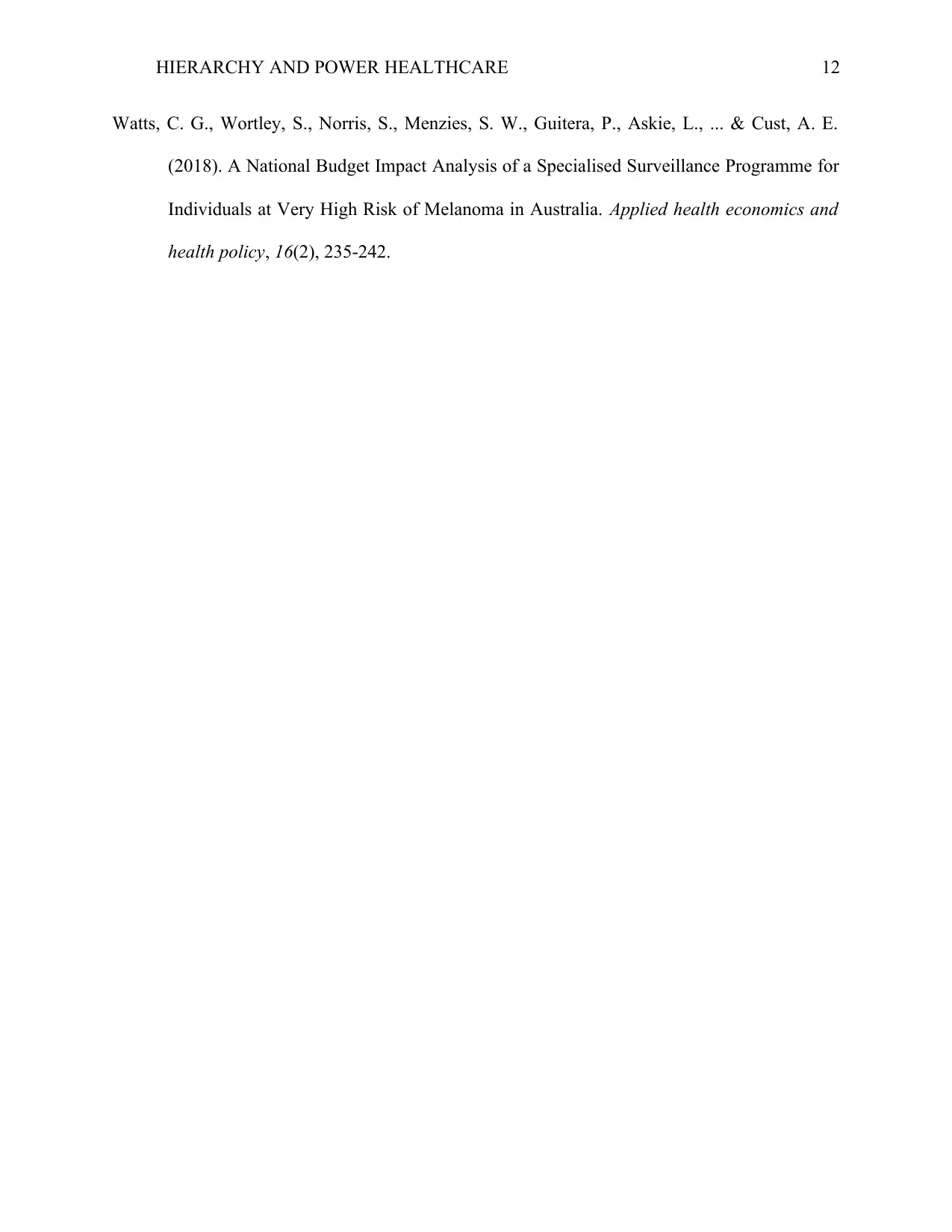
HIERARCHY AND POWER HEALTHCARE 12
Watts, C. G., Wortley, S., Norris, S., Menzies, S. W., Guitera, P., Askie, L., ... & Cust, A. E.
(2018). A National Budget Impact Analysis of a Specialised Surveillance Programme for
Individuals at Very High Risk of Melanoma in Australia. Applied health economics and
health policy, 16(2), 235-242.
Watts, C. G., Wortley, S., Norris, S., Menzies, S. W., Guitera, P., Askie, L., ... & Cust, A. E.
(2018). A National Budget Impact Analysis of a Specialised Surveillance Programme for
Individuals at Very High Risk of Melanoma in Australia. Applied health economics and
health policy, 16(2), 235-242.
1 out of 12
Related Documents
Your All-in-One AI-Powered Toolkit for Academic Success.
+13062052269
info@desklib.com
Available 24*7 on WhatsApp / Email
![[object Object]](/_next/static/media/star-bottom.7253800d.svg)
Unlock your academic potential
© 2024 | Zucol Services PVT LTD | All rights reserved.




